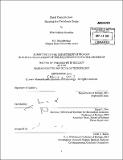Basal constriction : shaping the vertebrate brain
Author(s)
Graeden, Ellie Graham
DownloadFull printable version (12.50Mb)
Other Contributors
Massachusetts Institute of Technology. Dept. of Biology.
Advisor
Hazel L. Sive.
Terms of use
Metadata
Show full item recordAbstract
Organs are primarily formed from epithelia, polarized sheets of cells with an apical surface facing a lumen and basal surface resting on the underlying extracellular matrix. Cells within a sheet are joined by junctions, and changes in cell shape and size drive epithelial bending and folding during morphogenesis. These shape changes include constriction and expansion of the cell surfaces, elongation or shortening of the apical-basal length, or cell spreading. In this thesis, I present the first description of basal constriction, a process by which cells narrow on their basal surfaces to bend the neuroepithelium. Specifically, I describe morphogenesis of a major conserved bend in the vertebrate neural tube, the midbrain-hindbrain boundary constriction (MHBC). The MHBC forms between 17 and 24 hours post fertilization in zebrafish, concomitant with, but independent of ventricle inflation. Cells shorten to 75% the length of the surrounding cells prior to basal constriction, during which a band of 3-4 cells becomes wedge-shaped. Subsequently, these cells apically expand by twice the width of the surrounding cells. Basal constriction is laminin-dependent, with actin enriched at the basolateral surface of the constricted cells. Wnt5 is highly expressed specifically at the MHBC prior to and during basal constriction and is required for this process. Focal adhesion kinase (FAK) is activated by phosphorylation at the MHBC and is required for basal constriction. FAK activation at the MHBC is dependent upon Wnt5 function. Loss of basal constriction in Wnt5 and FAK loss-of-function embryos can be rescued by inhibiting Gsk3p. These data suggest a novel pathway in which Wnt5 activates FAK in conjunction with the inhibition of Gsk3P to drive basal constriction at the MHBC. This study is the first to describe basal constriction during epithelial morphogenesis and provides mechanistic insights into a newly described cell shape change required for normal brain development.
Description
Thesis (Ph. D.)--Massachusetts Institute of Technology, Dept. of Biology, February 2011. Cataloged from PDF version of thesis. Includes bibliographical references.
Date issued
2011Department
Massachusetts Institute of Technology. Department of BiologyPublisher
Massachusetts Institute of Technology
Keywords
Biology.